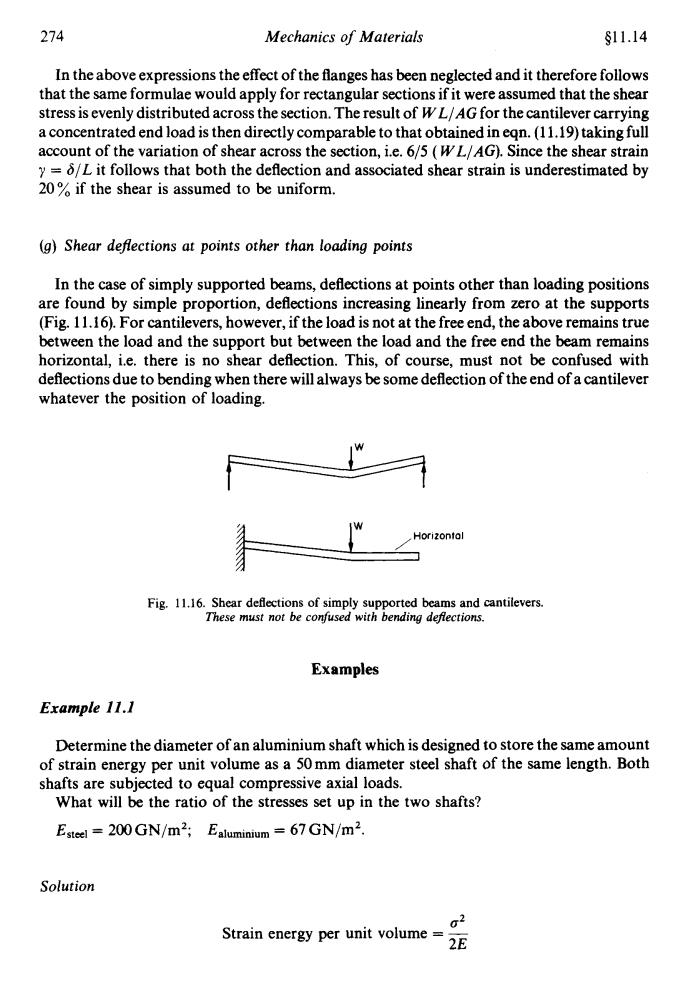正在加载图片...

274 Mechanics of Materials §11.14 In the above expressions the effect of the flanges has been neglected and it therefore follows that the same formulae would apply for rectangular sections if it were assumed that the shear stress is evenly distributed across the section.The result of WL/AG for the cantilever carrying a concentrated end load is then directly comparable to that obtained in eqn.(11.19)taking full account of the variation of shear across the section,i.e.6/5 (WL/AG).Since the shear strain y=/L it follows that both the deflection and associated shear strain is underestimated by 20%if the shear is assumed to be uniform. (g)Shear defections at points other than loading points In the case of simply supported beams,deflections at points other than loading positions are found by simple proportion,deflections increasing linearly from zero at the supports (Fig.11.16).For cantilevers,however,if the load is not at the free end,the above remains true between the load and the support but between the load and the free end the beam remains horizontal,i.e.there is no shear deflection.This,of course,must not be confused with deflections due to bending when there will always be some deflection of the end of a cantilever whatever the position of loading. Horizontol Fig.11.16.Shear deflections of simply supported beams and cantilevers. These must not be confused with bending defections. Examples Example 11.1 Determine the diameter of an aluminium shaft which is designed to store the same amount of strain energy per unit volume as a 50 mm diameter steel shaft of the same length.Both shafts are subjected to equal compressive axial loads. What will be the ratio of the stresses set up in the two shafts? Esteel =200 GN/m2;Ealuminium =67GN/m2. Solution σ2 Strain energy per unit volumeE274 Mechanics of Materials 411.14 In the above expressions the effect of the flanges has been neglected and it therefore follows that the same formulae would apply for rectangular sections if it were assumed that the shear stress is evenly distributed across the section. The result of WL/AG for the cantilever carrying aconcentrated end load is then directly comparable to that obtained in eqn. (1 1.19) taking full account of the variation of shear across the section, i.e. 6/5 ( WL/AG). Since the shear strain y = 6/L it follows that both the deflection and associated shear strain is underestimated by 20% if the shear is assumed to be uniform. (g) Shear dejlections at points other than loading points In the case of simply supported beams, deflections at points other than loading positions are found by simple proportion, deflections increasing linearly from zero at the supports (Fig. 11.16). For cantilevers, however, if the load is not at the free end, the above remains true between the load and the support but between the load and the free end the beam remains horizontal, Le. there is no shear deflection. This, of course, must not be confused with deflections due to bending when there will always be some deflection of the end of a cantilever whatever the position of loading. Fig. 11.16. Shear deflections of simply supported beams and cantilevers. These must not be confused with bending de$ections. Examples Example 11.1 Determine the diameter of an aluminium shaft which is designed to store the same amount of strain energy per unit volume as a 50mm diameter steel shaft of the same length. Both shafts are subjected to equal compressive axial loads. What will be the ratio of the stresses set up in the two shafts? Esteel = 200 GN/m2; Ealuminium = 67 GN/mZ. Solution 02 Strain energy per unit volume = - 2E